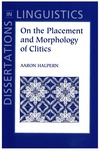Using data from a variety of languages, this book investigates the place of clitis in the theory of language structure, and their implications for the relationships between syntax, morphology and phonology. Aaron Halpern asserts that the theory of language requires the recognition of at least two distinct classes of clitics, one with the syntax of independent phrases and the other with the syntax of inflectional affixes. He goes on to distinguish these classes on the basis of both distributional and morphological differences.
Aaron Halpern was a postdoctoral research associate at Los Alamos National Laboratory at the time of this publication.
- Preface
- 1. Introduction
Part I The distribution of bound words
- 2. Second Position and Prosodic Inversion
- 2.1 Second Position
- 2.2 Outlines of the Analysis
- 2.3 Controlling the Alternation
- 2.4 Complementarity of 2D and 2W
- 2.5 Prosodic Inversion and Verbal Clitics
- 2.5.1 Bulgarian
- 2.5.1 Old French
- 2.6 Other Types of Clitics
- 2.7 Domains of 2P clitics: Sanskrit and Ancient Greek
- 2.8 2P Clitics Are Syntactically Initial in Their Domains
- 2.9 Alternative Theories of Clitic Placement
- 2.9.1 Against Pure Syntax
- 2.9.1.1 The Notion of Leftmost Node
- 2.9.1.2 Discontinuous Constituency
- 2.9.2 Against Nonsyntactic Analysis
- 2.10 The Syntax of Clitics
- 2.11 Comparing the Positioning Verbs and (2P) Clitics
- 2.12 Defining Prosodic Inversion Purely Prosodic?
- 2.13 Comparing the Positioning Verbs and (2P) Clitics
- 2.13.1 Skipping and Sentence-Internal
- 2.13.2 Fortresses
- 3. The Superclausal Syntax of Serbo-Croation
- 3.1 Basics of Wh-Movement
- 3.2 2W Revised
- 3.3 The Syntax of Discontinuous Wh-Phrases
- 3.4 Multiple WH Questions
- 3.5 Long WH Fronting
- 3.6 CleftP and the Position of Clitics
Part II Lexical Clitics and Extended Inflection
- 4. The English Possessive
- 4.1 Lexical Attachment: Z Haplology
- 4.1.1 Head-final NP's
- 4.1.2 Complex NP's
- 4.1.3 Summary
- 4.2 Basics of the Extended Inflection Account
- 4.3 Problems with Zwicky
- 4.3.1 Problems with Linear Precedence
- 4.3.2 Possessive Pronouns
- 4.3.3 Double Marking: the case of mine's
- 4.4 Resolution: Distinguishing POSS and PM
- 4.5 Ordinals and Factions: Marking Versus Trigger Features
- 4.6 Coordination and Trigger Features
- 4.7 Double-Z dialects
- 4.8 NP's with Null N's
- 4.9 NP's with Final Wh-Traces
- 4.10 On *John and me's
- 4.11 Summary and Comparison
- 5. Other Lexical Clitics
- 5.1 The Distributional Range of Lexical Clitics
- 5.1.1 The Edge of a Phrase
- 5.1.2 In the Second Position
- 5.1.2.1 Ngiyambaa
- 5.1.2.2 Polish
- 5.1.3 On thee Head of a Phrase
- 5.1.4 A Missing Type
- 5.1.5 Prospects: Extending Extended Inflection
- 5.2 The Balkan Definite Article and Psuedo-Second Position
- 5.2.1 Phonology
- 5.2.2 Second Position
- 5.2.3 Some Similar Phenomena
- 5.2.3.1 Amharic Articles
- 5.2.3.2 The Zoque Plural
- 5.2.4 Informal Analysis
- 5.2.5 Against “Minimal Recording”
- 5.3 Details of the Balkan Article
- 5.3.1 Demonstratives and Kinship Terms
- 5.3.2 Cordination
- 5.3.3 Lexical Gaps
- 5.3.4 Multiple Marking
- 5.3.5 Clitic Possessive Pronouns
- 5.3.5.1 Rumanian
- 5.3.5.2 Bulgarian
- 5.4 The Marking Feature Principle and the Variety of Lexical Clitics
- 5.5 Lexical Verbal Clitics
- 5.5.1 Macedonian
- 5.5.2 Modern French
- 5.5.3 Implications
- 5.6 Inflections and Lexical Clitics
- 5.7 Conclusion
Part III Cluster Morphology
- 6. Multiple clitics and Morphological Clusters
- 6.1 Clusters om Sekani
- 6.1.1 Introduction
- 6.1.2 The Stem-Core Hypothesis and Bracket Erasure
- 6.1.3 An Alternative: Compounding
- 6.1.4 Evaluating the Compounding Hypotheis
- 6.1.4.1 Arguments for a Conjunct Prefix Domain
- 6.1.4.2 No Inner-Prefix Plus Stem Domain
- 6.1.4.3 Syllabication and the Licensing of Codas
- 6.1.4.4 The Status of Classifiers
- 6.1.5 Morphological Constituency and Phonological Rule Domains
- 6.1.6 Summary of the Sekani Verb
- 6.2 Morphology and Syntax in Ordering
- 6.3 The Formation of Clusters
- 6.3.1 Syntactic Subcategorization
- 6.3.2 Prosodic Subcategorization
- 6.3.3 Composition of Prosodic Subcategorization
- 6.3.4 Morphological Subcategorization
- 6.4 Motivating Morphological Subcategorization
- 6.5 Conclusions
- 6.A Reference to level 1 brackets in Sekani
- 6.B The ordering of the clitics from different domains
- Afterword
- Bibliography
1/1/95


